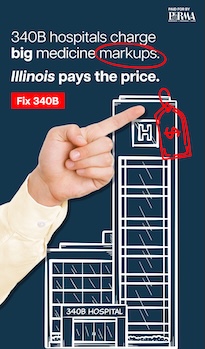Today’s quotable
Thursday, Aug 4, 2016 - Posted by Rich Miller
* Stateline…
“If the state had shut down, you better believe we would have had a budget by now — and everybody knows it,” said Illinois Sen. Toi Hutchinson, the Democratic chairwoman of the Revenue Committee. “We can’t even shut the state down right.”
Thoughts?
33 Comments  
|
* Press release…
The Liberty Justice Center has filed a federal lawsuit to strike down Illinois’ Election Day voter registration law. The lawsuit shows that this law violates the Equal Protection Clause of the 14th Amendment by making it more difficult for people to register to vote in some areas of the state than in others.
In 2014, the Illinois General Assembly passed a law creating a system for Election Day voter registration in Illinois. The law is unlike any other voter registration law in the U.S. because the availability of Election Day voter registration at polling places varies by county. The law requires counties with populations of 100,000 or more to offer Election Day voter registration at all polling places. However, the law does not require counties with lower populations to offer Election Day voter registration at all polling places – making it more difficult for people to register to vote in some areas of the state than in others.
Every state senator and representative who voted for this scheme was a Democrat, and every state senator and representative who voted against it was a Republican. Not coincidentally, high-population counties in Illinois tend to favor Democratic candidates; low-population counties in Illinois tend to favor Republican candidates. Former Gov. Pat Quinn signed the law during his final days in office.
“Illinois’ voter registration law is unconstitutional. The state cannot give some citizens better opportunities to vote than it gives to others,” said Jacob Huebert, senior attorney at the Liberty Justice Center. “If Illinois is going to have Election Day voter registration at polling places, it should be available statewide. And it should be fair.”
The plaintiffs in this case are Patrick Harlan, a candidate for Congress in Western Illinois, and the Crawford County Republican Central Committee.
The lawsuit asks the federal court to order the Illinois State Board of Elections to direct election authorities in all 102 Illinois counties not to provide Election Day registration at precinct polling places in the November election. That’s the only way a federal court can fix the unfairness of this law. Or, the General Assembly could fix the unfairness of the law by changing it, so that Election Day registration is available at polling places everywhere – not just in places where one political party wants to boost its turnout.
The center was created by the Illinois Policy Institute.
The filing is here. Video of its press conference is here. The group wants a preliminary injunction issued before this November’s election.
When asked why the group waited so long to file the lawsuit, the center’s spokesperson said “We didn’t notice it a year ago.”
*** UPDATE *** Dave McKinney…
State Senator Don Harmon, a Democrat from suburban Chicago and the law’s chief Senate sponsor, said Illinois law commonly differentiates between counties’ populations and said election officials in less-populous counties voiced concern about not having resources for polling place registration.
Under the law in question, voters in smaller counties can still register on Election Day in county clerks’ offices.
Harmon suggested the lawsuit’s real aim is to dampen Democratic voter turnout this fall, particularly in party strongholds like Cook County. In 2015, there were 4 million residents in the county above the voter-eligible age of 18, according to the U.S. Census. […]
“I suspect the plaintiffs are much more interested in having same-day registration thrown out in Cook County than they are in extending it to every small county in Illinois,” Harmon said.
If I was going to put on my tinfoil hat, I’d say it also has something to do with contested legislative races. The Institute is a major Rauner ally and he’s dumping millions of dollars into those races.
41 Comments  
|
Question of the day
Thursday, Aug 4, 2016 - Posted by Rich Miller
* Hmm…
* From the linked story…
In an increasingly contentious presidential campaign, just a quarter of voters who support Donald Trump in the general election say they have a lot or some close friends who are supporters of Hillary Clinton. Even fewer Clinton backers (18%) say they have at least some friends who support Trump.
Nearly half of Clinton supporters (47%), and 31% of Trump supporters, say they have no close friends who support the opposing candidate.
* The Question: Do you maintain any active close friendships with people on the other side of this election? Take the poll and then explain why or why not in comments, please.
bike trails
63 Comments  
|
Because… Madigan
Thursday, Aug 4, 2016 - Posted by Rich Miller
* A News-Gazette editorial discusses the potential 2018 Democratic candidates for governor and concludes…
Serious candidates should ask themselves: “How badly do I want to be governor if Mike Madigan is really calling the shots?”
It’s a good question. Pat Quinn was widely viewed as hapless, and that was at least partly the result of him never figuring out how to constructively engage with the House Speaker - and a lot of that falls on Madigan himself.
After Madigan lost the majority in 1994, he pledged to change his ways if he regained power. And he mostly did. He worked with Jim Edgar for the next two years and George Ryan for four years. And he cooperated with Rod Blagojevich for a year after Blagojevich’s first election. But then, it all went downhill.
Frankly, I have no idea why Dick Durbin or anybody else would want to endure the brutality of a campaign against a deep-pocketed Bruce Rauner for a year only to wind up getting the tar knocked out of them by MJM for the next four years.
23 Comments  
|
* Sun-Times…
Mayor Rahm Emanuel on Wednesday put in place the final piece of the pension puzzle he was elected to solve but in a way that will impose another heavy burden on Chicago homeowners reeling from rising property taxes compounded by reassessments.
To generate the $239 million over five years needed to save Chicago’s largest city employee pension fund, Emanuel wants to slap a new and quickly escalating “utility tax” on water and sewer bills over the next four years.
The plan is to start with a 7 percent tax, double it in year two, impose a 21 percent tax in year three and end at 28 percent in years four and five.
After that, the tax would rise annually to meet the “actuarially required contribution” to achieve a 90 percent funding ratio by 2057 for a Municipal Employees pension with $18.6 billion in unfunded liabilities that is due to run out of money in 2025. […]
It is expected to cost the average homeowner $4.43 more month or $53.16 a year in 2017. In the fourth year, the added tax burden will be $225.96 a year.
* ABC 7…
Last year, aldermen passed a record property tax increase to resolve shortfalls in the police and firefighter pensions and raised the cell phone tax to shore up the laborers’ retirement fund. They also tacked on a garbage pickup fee to the aforementioned water bills that were increased sharply in 2012 to rebuild mains and sewers.
“We’ve doubled the water rates historically and now we’ve added the garbage fees, so there’s a lot of frustration in our neighborhood,” said Ald. Tom Tunney (44th Ward). […]
Another reason Emanuel ruled out another city property tax increase is that the Chicago Public Schools system has been authorized to raise its levy by $250 million and is expected to do so later this month.
* And the mostly ignored reforms Emanuel is pushing…
The mayor plans to ask the General Assembly and Republican Gov. Bruce Rauner to sign off on altering the municipal fund pension system to save about $2 billion over the next 40 years. The legislative changes to the pension fund would require newly hired employees, starting next year, to increase their retirement account contributions to 11.5 percent of their salary from 8.5 percent.
Employees who were hired from 2011 to 2016 and already receive lower retirement benefits would have the option of increasing their contributions to 11.5 percent. In exchange, they would be eligible to retire at age 65 instead of 67.
But employees hired before 2011 would see no changes, after the Illinois Supreme Court struck down Emanuel’s earlier attempt to reduce their benefits, citing a constitutional clause that states their benefits shall not be diminished or impaired. “You can’t touch existing employees, that’s walled off,” Emanuel told investors.
Emanuel and affected unions have an “agreement in principle” on identical changes to the much smaller city laborers fund, with additional city contributions coming from a $1.90-per-month-increase on landline and cellphones billed to city addresses that was approved by the City Council two years ago.
25 Comments  
|
“Busy Week in Court for Independent Maps”
Thursday, Aug 4, 2016 - Posted by Advertising Department
[The following is a paid advertisement.]
The Illinois Supreme Court has accepted an amicus brief filed by the following organizations urging the state’s highest court to let voters have a say on transparent, impartial and fair redistricting in November:
• League of Women Voters of Illinois
• Small Business Advocacy Council
• CHANGE Illinois
• Illinois Campaign for Political Reform
• Rockford Chamber of Commerce
• McCormick Foundation
• Champaign County Chamber of Commerce
• Business and Professional People for the Public Interest (BPI)
• Sargent Shriver National Center on Poverty Law
• Latino Policy Forum
• Illinois Public Interest Research Group
• West Rogers Park Community Organization
• Metropolitan Planning Council
• Better Government Association
• Chicago Southside Branch NAACP
• Independent Voters of Illinois-Independent Precinct Organization
• Union League Club of Chicago
• Illinois Farm Bureau
• Naperville Area Chamber of Commerce
• Chicagoland Chamber of Commerce
• Common Cause
• Illinois Chamber of Commerce
• Citizen Advocacy Center
• The Civic Federation
• The Commercial Club of Chicago
• Chicago Embassy Church
• Illinois Hispanic Chamber of Commerce
To read more, click here.
Comments Off  
|
* Tribune editorial…
On Monday, Illinois citizens were jolted by a piercing pain in the wallet as federal officials unveiled proposed Obamacare insurance premium rates for 2017. Insurers plan to dial up rates as much as a heart-stopping 45 percent for those who buy plans on the Obamacare marketplace when open enrollment starts Nov. 1.
That means thousands of people will scramble for affordable insurance … and won’t find it.
* From the US Department of Health & Human Services…
Statement by Press Secretary Jonathan Gold on Illinois health insurance rate changes:
“Consumers in Illinois will continue to have affordable coverage options in 2017. Last year, the average monthly premium for people with HealthCare.gov coverage getting tax credits increased just $4 from $102 to $106 per month, despite headlines suggesting double digit increases. People in Illinois understand how the Marketplace works, and they know that they can shop around and find coverage that fits their needs and budget. In fact, last year more than 53 percent of them did exactly that by switching plans to save money. In addition, the vast majority of consumers in Illinois qualify for tax credits that reduce the cost of coverage below the sticker price. Today’s announcement is just the beginning of the rates process, and consumers will have the final word when they vote with their feet during Open Enrollment.”
Background
Proposed rates aren’t what consumers pay. While today’s filings show an average rate increase in Illinois, a report from the U.S. Department of Health and Human Services demonstrates that proposed premium changes from preliminary rate filings do not capture what Marketplace consumers actually pay. Last year, the average monthly premium for people with HealthCare.gov coverage getting tax credits increased just $4 from $102 to $106 per month, despite headlines suggesting double digit increases.
Most people receive tax credits and can buy a plan for less than $75 per month.
75% of Marketplace consumers in Illinois receive tax credits, which are designed to protect consumers from premium increases and help make coverage affordable.
Tax credits increase if the cost of the second lowest-cost silver, or benchmark, plan goes up. So if all premiums in a market go up by similar amounts, 75% of Marketplace consumers in that market will not necessarily pay more because their tax credits will go up to compensate. Average rate increases reported with the preliminary rate filings do not account for tax credits.
For 2016 coverage, 53% of customers in Illinois had the option of selecting a plan with a premium of $75 or less per month after tax credits.
Shopping: The ACA Marketplace helps consumers shop around for the best deal.
Prior to the ACA, it was nearly impossible for consumers to compare plans and shop around easily – and many Americans went uninsured because they couldn’t afford insurance or had pre-existing conditions. Those who did have insurance in the individual market were often trapped in the plan they had, since people with even small health problems could be denied coverage or charged an exorbitant price if they tried to switch plans or issuers.
Today, Marketplace consumers in Illinois can purchase any available plan regardless of health conditions, and tools such as the doctor lookup and out-of-pocket cost calculator help them find the plan that meets their needs. Last year, 53% of returning Marketplace consumers in Illinois switched plans. They saved an average of $636 annually.
Based on an examination of preliminary 2017 rate filings for nine states that released rates earlier this year, Avalere found that the average rate increase for lowest and second-lowest cost silver plans was 7-8%, about half the overall average rate increase in these states. That difference highlights how consumers can benefit from shopping around.
A major new issuer, Cigna, has indicated it will begin offering plans in the Chicago area for 2017, which will further bolster choice and competition in the Illinois Marketplace.
Prior to the Affordable Care Act, plans were typically inferior and excluded services like maternity care, or even routine services like prescription drugs. Plans also often charged a higher premium, or denied coverage altogether, to consumers due to a pre-existing condition. Now, all consumers have the option to purchase quality, affordable coverage.
This is a big deal for as many as 5,636,000 people in Illinois with a pre-existing condition.
Preliminary rates aren’t final rates. Preliminary rates often change significantly before being finalized. In particular, they are subject to rate review, which led to $1.5 billion in savings for consumers in 2015. Last year, final rates in some states were below proposed rates.
Health insurance is clearly something people in Illinois like, want, and need: 388,179 people signed up for 2016 coverage through the Marketplace.
Since major provisions of the Affordable Care Act went into effect, Illinois’ uninsured rate fell from 14.2 percent in 2013 to 7.9 percent in 2015 for non-elderly residents, according to new data released recently.
Both Marketplace and non-Marketplace consumers continue to benefit from the low health care cost growth of recent years.
Marketplace rates remain well below expectations when the law was passed. Marketplace rates for 2014 came in about 15% below Congressional Budget Office (CBO) projections in 2010. Better-than-expected Marketplace premiums are due in large part to lower-than-expected economy-wide health care cost growth and other efficiencies.
For the half of Americans who obtain health insurance through an employer, premiums for family coverage grew by an average of 5% per year from 2010 to 2015 – compared with about 8% per year from 2000 to 2010. Premiums grew at an even slower 4.2% rate in 2015. If premium growth since 2010 had matched the average growth rate over the prior ten years, the average family premium would have been almost $2,600 higher in 2015.
All emphasis was in the original.
33 Comments  
|
* From the Commission on Government Forecasting and Accountability…
Over the past fiscal year, the lack of an enacted budget has resulted in the State Employee Group Insurance Program (SEGIP) building up a large backlog of unpaid claims. As of the end of June, approximately $3.34 billion in claims were being held by the state from various insurers, organizations, and companies.
Of this total, the largest portion was approximately $1.6 billion of HMO/Medicare Advantage claims. The second largest portion, Open Access Plans, totaled $741.2 million. The third largest portion of the overall claims hold came from CIGNA, which had $556 million in claims currently held by the state.
Concurrently, the estimated time for claims to be held was 314-557 days for Managed Care, 477-547 days for Open Access Plans, and 497-574 days for CIGNA. […]
Despite a stop-gap budget being passed, however, claims will continue to build up and estimated claims hold times will increase due to no appropriation for Group Insurance.
Ugh.
38 Comments  
|
* Lax environmental oversight…
Analyzing thousands of pages from state agencies including the Environmental Protection Agency, the Department of Natural Resources and the attorney general’s office, the Tribune found that pollution incidents from hog confinements killed at least 492,000 fish from 2005 through 2014 — nearly half of the 1 million fish killed in water pollution incidents statewide during that period. Pig waste impaired 67 miles of the state’s rivers, creeks and waterways over that time.
Using either measure, no other industry came close to causing the same amount of damage. […]
Confinements with multimillion-dollar annual revenues often paid just a few thousand dollars in fines after causing massive fish kills. Many went to court to challenge authorities; since 2005, the state attorney general has filed or resolved at least 26 pollution lawsuits against swine confinements. Some operators polluted repeatedly. And the multistate pork producers who supply the pigs and profit from the confinements were rarely held accountable, the Tribune found. […]
In 2010, Illinois’ failure to monitor or regulate livestock confinements prompted the U.S. EPA to threaten funding cuts and decertification of the state EPA. Since then, Illinois has bolstered its inspections staff as well as documented and visited 236 of the largest swine facilities. That is fewer than half of the estimated 527 in the state and includes none of the additional 427 hog confinements with up to 2,500 animals.
* Lax animal welfare oversight…
Weeks after taking a job as a breeding technician at Eagle Point Farms, an anguished Sharee Santorineos sat down and wrote a three-page whistleblower complaint.
“I seen pigs that are pregnant beat with steel bars,” said her letter to the Illinois Bureau of Animal Health and Welfare. “I seen them kicked all over their body.” […]
Instead, like other worker allegations about animal abuse in Illinois’ 900-plus hog confinement facilities, Santorineos’ account went nowhere.
After Eagle Point executives gave a state bureau inspector a guided tour of the 6,000-pig operation, he wrote a single-page report.
“I did not observe anyone mistreating the animals,” it said. “No violations found. Docket is closed.”
The state has regularly discounted or dismissed such worker complaints, a Tribune investigation has found. In the Illinois hog confinements that send 12 million pigs to market annually, the bureau did not find a single animal welfare infraction or violation during the past five years, the Tribune found in reviewing thousands of pages of bureau records.
* Unchecked foreign corporate encroachment…
Still, the system was working for them until the mid-1990s brought punishing downswings in the market for live hogs — including a devastating 1998 price collapse. Big producers like Smithfield Foods and Cargill swooped in, Steele recalled, and enticed farmers to become “contract growers” instead of raising their own pigs.
It was a way for many to insulate themselves from market risk and remain on their land rather than shutting down altogether.
“For our generation, we all wanted to come back to the farm, and this has enabled us to do so,” said Genny Six, a contract grower whose Morgan County operation in central Illinois has steadily expanded to 7,200 pigs.
Then came the most recent seismic shift: China’s largest meat processor purchased Smithfield Foods for $4.7 billion while a Brazilian firm paid $1.45 billion last year to acquire Cargill’s U.S.-based pork business.
“It used to be, the farmer raised the corn that fed his pigs here in Illinois, they got harvested by a packing plant here in Illinois and they probably got consumed here in Illinois,” said western Illinois hog farmer Greg Giertz. “Now the hogs might be owned by someone in Iowa, raised in Illinois, slaughtered in Indiana and shipped to China.”
* And an exploding marketplace…
Across Illinois, the nation’s fourth-largest seller of pigs, large hog confinements have exploded in number and size. Raising pigs for slaughter in an efficient, factorylike setting, the operations help hold down the price of the most widely consumed meat in the world. […]
Other states and local agencies have moved aggressively to address the problems caused by large hog confinements. Illinois has not, the Tribune found, even as consumers demand more humane treatment of livestock and stronger environmental protections. […]
With the pace of new construction permits accelerating, state authorities say they are doing the best they can to protect neighboring communities and the environment. But they acknowledge that Illinois’ Livestock Management Facilities Act gives them few tools to hold confinement owners accountable.
Twenty years after the state law was put in place, critics liken its provisions to a frontier-era timber blockade in the path of a bullet train.
29 Comments  
|
What bipartisan cooperation can accomplish
Thursday, Aug 4, 2016 - Posted by Rich Miller
* From Rebecca Shi, the director of the Illinois Business Immigration Coalition…
Hello Rich,
Hope your summer is going great! Governor Rauner signed into law a bill providing health insurance for 41,000 undocumented children. We are celebrating this Friday with Archbishop Blase Cupich, Minority leader Jim Durkin, Latino caucus co-chairs Iris Martinez and Lisa Hernandez, and 350 business, faith, and Latino Asian leaders. Wondering if you would you be interested in this story?
I wholeheartedly believe that this is one bright spot in this year’s Springfield fight: Bi-partisan support for renewal of health care for 41,000 undocumented children in Illinois, passed legislation in the House and Senate with the support of all four legislative leaders, and Gov. Rauner signed the bill. In this era of Trump and his wall, the national anti-immigrant groups weighed in against this legislation and they were crushed.
We had active support from the grass-roots, the faith community (especially Catholics), the business community (including Susan Crown and Bill Kunkler, who put an op ed in the Tribune, Exelon’s John Rowe and Crate and Barrel’s Carole Segal), and the united healthcare community. A beautiful piece of organizing.
I hope perhaps you can tell this story. It is both ironic and beautiful that the MOST vulnerable and least politically relevant people - undocumented children - was where Rauner and Madigan agreed to sheath their swords and each actively worked to move towards a successful resolution.
* Mark Brown has a column about the law today…
Even as Donald Trump was wrapping up the Republican presidential nomination in part with his get-tough rhetoric on immigration, Illinois political leaders moved in a decidedly different direction in the waning days of the spring legislative session.
With bipartisan support that included backing from Gov. Bruce Rauner, lawmakers renewed a state health insurance program for low-income children that includes coverage for undocumented youth.
* A few important points from Brown’s column…
Such celebrations are often held as part of bill-signing ceremonies, but in this case, Rauner quickly signed the legislation to beat a July 1 deadline and is not expected to attend Friday’s festivities. […]
Sen. Chris Nybo of Elmhurst, one of many Republicans who supported the bill, argued that it is in keeping with his pro-life philosophy.
“Being supportive of children and families should transcend immigration status,” Nybo said. […]
House Speaker Mike Madigan and Senate President John Cullerton kept the bill separate from other Medicaid-funding legislation to keep it from getting caught up in the partisan budget wars.
* Like with his signature on the Right of Conscience Act revisions opposed by the far right and all the new criminal justice reform measures he’s backed, the governor has tried to tamp down coverage of his signatures by signing potentially controversial bills without comment. It’s mostly worked. The uproar over the Right of Conscience Act bill has received almost no mainstream media coverage. And I doubt many people beyond those who read this blog are aware of all the new criminal justice reforms.
Also, Sen. Nybo put to voice something I’ve heard others say. Almost every pro-life legislator (except a few like Nybo) voted against that All Kids bill, despite the fact that it will almost certainly save the lives of newborn infants. And since it came with a 90 percent federal match, it’ll save Illinoisans some cash because those costs won’t be shifted to providers, who then shift those costs to people who have insurance.
And good on all four legislative leaders and the governor for doing their very best to keep this out of the impasse war. Without that cooperation, the bill would’ve never become law.
64 Comments  
|
Unpaid bereavement leave now law
Thursday, Aug 4, 2016 - Posted by Rich Miller
* As we’ve discussed a few times already, Gov. Rauner signed a whole lot of bills last Friday before clearing this week’s schedule. Bernie writes about another one…
Gov. BRUCE RAUNER last week signed Senate Bill 2613, which provides that employees are entitled to up to 10 workdays of unpaid bereavement leave following the death of a child.
Among advocates for the bill was JIM DIXON of Springfield. He and his wife, LINDA, lost a son, TODD, in a one-car accident 25 years ago, and they lead a group call Bereaved Parents of Springfield. Jim Dixon is also president of the Springfield and Central Illinois Trades and Labor Council.
The bill applies to private-sector businesses that employ 50 or more employees for at least 20 work weeks in a year.
“The pain a parent who loses a child must experience is unimaginable,” said state Sen. JENNIFER BERTINO-TARRANT, D-Shorewood, chief sponsor of the legislation. She said she was saddened to learn that while the Family and Medical Leave Act allows time off to care for a sick child, there was not a similar provision for time upon the death of a child.
“Since introducing this bill, I have heard many stories of parents feeling they were not mentally prepared to go back to work so quickly or needed more time to grieve,” Bertino-Tarrant said. “I am grateful parents now have this guarantee.”
Discuss.
14 Comments  
|
Emanuel takes “cheap” shot at Rauner
Thursday, Aug 4, 2016 - Posted by Rich Miller
* Hal Dardick…
Mayor Rahm Emanuel was talking to the Chicago Investors Conference on Wednesday when one investor asked him to comment on the fact that the mayor’s idea of pursuing “reform with revenue sounds similar to the governor’s turnaround agenda.”
“Yeah, well we got it done,” Emanuel said in reference to Rauner’s failure to get much of his agenda through Springfield, and the mayor’s relative success in getting his pension funding plans approved.
“That was cheap,” he said as the crowd laughed. “That was not fair. Just couldn’t help myself.”
43 Comments  
|
|
 Support CapitolFax.com
Support CapitolFax.com
Visit our advertisers...
  ...............
...............
 ...............
...............
 ...............
...............
 ...............
...............


|
   
|
Hosted by MCS |
SUBSCRIBE to Capitol Fax |
Advertise Here |
Mobile Version |
Contact Rich Miller
|













